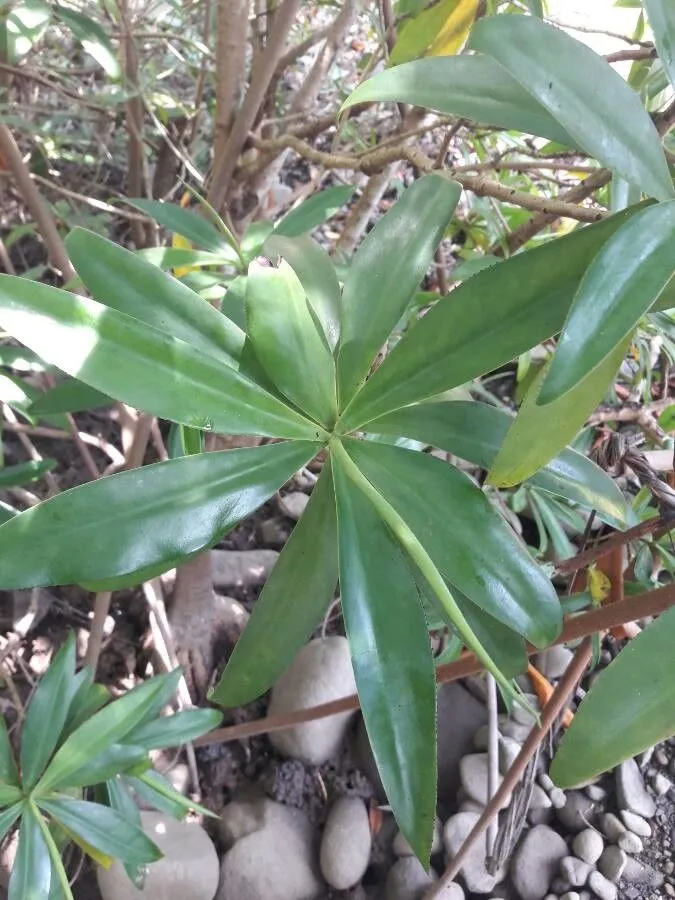
Author: Planch. & Triana
Bibliography: Ann. Sci. Nat., Bot., sér. 4, 17: 381 (1862)
Year: 1862
Status: accepted
Rank: species
Genus: Pelliciera
Vegetable: False
Observations: C. America to Ecuador
The Tea mangrove, known scientifically as Pelliciera rhizophorae, is a distinctive and important plant native to the coastal regions ranging from Central America to Ecuador. First documented in 1862 by the botanists Planchon and Triana, its fascinating evolutionary characteristics and environmental significance have made it a subject of interest for botanists and ecologists alike.
Pelliciera rhizophorae belongs to the family Tetrameristaceae, a small family of flowering plants. Despite its limited family association, the Tea mangrove plays a crucial role in its native habitats. It is typically found in mangrove ecosystems, which are unique intertidal zones where saltwater and freshwater mix, creating a challenging environment where only specially adapted plants like the Tea mangrove can thrive.
These mangroves are vital for maintaining coastal ecosystems. They provide critical habitat and nursery grounds for a variety of marine and terrestrial species. The Tea mangrove, with its distinctive pneumatophores (aerial roots), helps stabilize the shoreline, reduces erosion, and offers protection against strong coastal winds and storms. These roots also facilitate gas exchange, a key adaptation that allows the Tea mangrove to survive in oxygen-poor sediments typical of mangrove environments.
Ecologically, Pelliciera rhizophorae supports biodiversity by providing food and shelter for numerous species of fish, crustaceans, and birds. The dense root systems are particularly important for juvenile fish, serving as a safe haven from predators.
From a botanical perspective, the Tea mangrove has unique features apart from its common mangrove relatives. Its leaves and flowers are quite distinct; the flowers are characterized by their vibrant colors and specific structural details. This plant has a variety of uses for local populations, including traditional medicine and sometimes in rituals, although it is not as commonly exploited as other mangrove species.
Conservation is a critical aspect when discussing the Tea mangrove. The coastal ecosystems where these plants thrive are often under threat from human activities such as deforestation, pollution, and climate change. Conservation efforts are essential to preserve these unique and vital ecosystems, ensuring that Pelliciera rhizophorae continues to play its role in maintaining the ecological balance of coastal environments.
In summary, the Tea mangrove, Pelliciera rhizophorae, is a vital plant species within the mangrove ecosystems from Central America to Ecuador. It contributes significantly to the stability and biodiversity of these coastal regions. First described in the mid-19th century, its ecological importance and unique adaptations make it a fascinating subject of study and conservation.
Spa: manglar piñuelo
En: Tea Mangrove
Es: Manglar Piñuelo
: Tea mangrove
Taken Aug 6, 2014 by Nelson Zamora Villalobos (cc-by-nc)
Taken Aug 6, 2014 by Nelson Zamora Villalobos (cc-by-nc)
Taken Aug 6, 2014 by Nelson Zamora Villalobos (cc-by-nc)
Taken Nov 20, 2019 by Venegas-Elizondo Carlos (cc-by-sa)
Taken Nov 20, 2019 by Venegas-Elizondo Carlos (cc-by-sa)
Taken Aug 6, 2014 by Nelson Zamora Villalobos (cc-by-nc)
Taken Aug 6, 2014 by Nelson Zamora Villalobos (cc-by-nc)
Taken Sep 9, 2019 by Venegas-Elizondo Carlos (cc-by-sa)
Taken Sep 9, 2019 by Venegas-Elizondo Carlos (cc-by-sa)
Taken Aug 6, 2014 by Nelson Zamora Villalobos (cc-by-nc)
Taken Nov 20, 2019 by Venegas-Elizondo Carlos (cc-by-sa)
Taken Oct 6, 2020 by Suarez Ana Paula (cc-by-sa)
Taken Nov 15, 2022 by rebecca todus (cc-by-sa)
Taken Nov 15, 2022 by rebecca todus (cc-by-sa)
Taken Sep 9, 2019 by Venegas-Elizondo Carlos (cc-by-sa)
Taken Nov 20, 2019 by Venegas-Elizondo Carlos (cc-by-sa)
© copyright of the Board of Trustees of the Royal Botanic Gardens, Kew.
© copyright of the Board of Trustees of the Royal Botanic Gardens, Kew.
© copyright of the Board of Trustees of the Royal Botanic Gardens, Kew.
Family: Myrtaceae Author: (F.Muell.) K.D.Hill & L.A.S.Johnson Bibliography: Telopea 6: 402 (1995) Year: 1995 Status:…
Family: Rubiaceae Author: Pierre ex A.Froehner Bibliography: Notizbl. Bot. Gart. Berlin-Dahlem 1: 237 (1897) Year:…
Family: Sapindaceae Author: Koidz. Bibliography: J. Coll. Sci. Imp. Univ. Tokyo 32(1): 38 (1911) Year:…
Family: Asteraceae Author: A.Gray Bibliography: Pacif. Railr. Rep.: 107 (1857) Year: 1857 Status: accepted Rank:…
Family: Fabaceae Author: Medik. Bibliography: Vorles. Churpfälz. Phys.-Ökon. Ges. 2: 398 (1787) Year: 1787 Status:…
Family: Aspleniaceae Author: (Cav.) Alston Bibliography: Bull. Misc. Inform. Kew 1932: 309 (1932) Year: 1932…